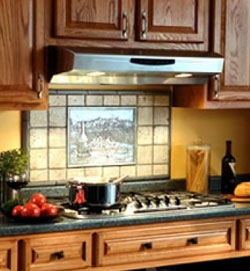Kitchen Stove Ventilation Fan
Attaining effective filtration and air circulation resulted from the kitchen stove ventilation fan implies choosing the right model from the start. Granted, while many experts in the field agree that the CFM can be decided by measuring the square footage of the kitchen and multiplying the number by two, it is necessary to point out that the type of cooker is an equally important aspect.
However, for normal residential kitchens with standardized equipment, there is no need to purchase an excessively powerful kitchen stove ventilation fan. On the other hand, a commercial cookery with a professional line of appliances will call for extra ventilation. The following guide will now list the main characteristics of a good kitchen exhaust ventilations system:
- Efficient air recirculation and filtration system
- Sufficiently powerful motor
- Easy to perform maintenance and cleaning on
- Low noise-pollution
- Fire hazard free
Let’s take a look at what each characteristic implies.
Efficient air filtration and circulation
Although the main principle of kitchen stove ventilation fan system is rather similar to most of the devices on the market, the construction does account for some differences. In essence, the kitchen stove ventilation fan should be able to effectively absorb most of the air filled with contaminants and particles resulted from cooking into the hood before they are able to spread in the entire air of the kitchen. Moreover, the filtering system should needs to capture and collect these particles in order for the air and moisture that will be ejected in the external air to be virtually clean.
Sufficiently powerful motor
A rather explanatory characteristic, the power of the motor integrated kitchen stove ventilation fan is basically measured in its ability to re-circulate air and is measured in cubic feet per minute. As explained in the beginning of the article, there is no clear formula, but only a few guidelines in how to make an effective purchase. It is also necessary to inquire whether the model is power efficient or if it will skyrocket the utility bills.
Easy maintenance
Although maintenance of the kitchen stove ventilation fan is necessary, that does not imply that it should be complex or difficult. Modern kitchen stove ventilation fan systems are built in a manner that allows users to easily detach and wash each individual part, from the hood, to the blade fans and air filters.
Low amount of noise
The larger and more powerful the kitchen stove ventilation fan, the more noise it will produce. However, the construction of the range hood and the proper positioning of the ductworks combined with a silent motor can help reduce the racket. On a side note, purchasing a model with adjustable speeds means that it does not always have to run at maximum power, which is obviously the loudest.
Fire hazard risk free
Since the filters of the kitchen stove ventilation fan tend to accumulate a great deal of particles over time, the hot air in conjunction with sparks from the cooker or the electrical system can easily set them aflame. Therefore, the filters should be fashioned from flame retardant or resistant materials in order to ensure this potential hazard is eliminated.

Categories
- Home
- Kitchen Ventilation Fan Ranges And Styles
- Decorative Range Kitchen Ventilation Fan
- Downdraft Kitchen Ventilation Fan
- Inline Kitchen Ventilation Fan
- Kitchen Stove Ventilation Fan
- Kitchen Ventilation Fan Hood
- Kitchen Ventilation Fan System
- Recirculating Range Kitchen Ventilation Fan
- Kitchen Ventilation Fan Information
- Types Of Kitchen Ventilation Fan
